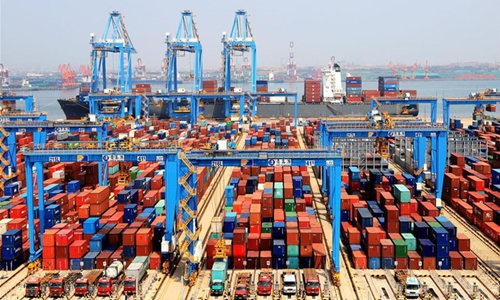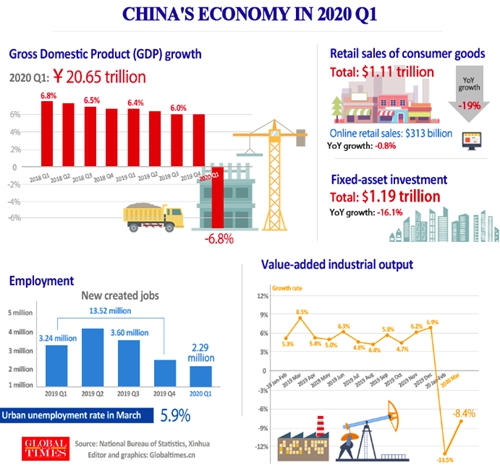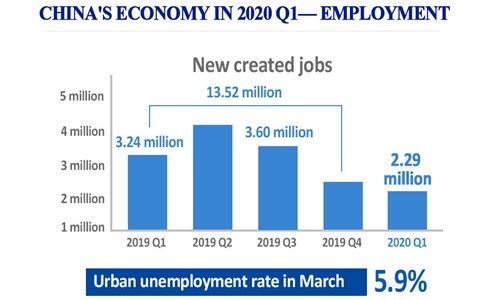China’s GDP slips 6.8% in Q1, first decline since 1992
By GT staff reporters Source:Global Times Published: 2020/4/17 10:07:07

GDP Photo: Xinhua
China’s economy contracted 6.8 percent in the first three months of the year, the first decline since 1992 when the nation started publishing quarterly GDP data.
While the first-quarter contraction represents the unavoidable price of controlling the deadly virus, the swift rebound in March data shows that China is mounting a steady recovery despite a global standstill due to the pandemic.
The figures for March also show that China’s positive long-term economic development trend has not changed, officials and economists said.
The 6.8-percent contraction translated to an economic loss of about 1.44 trillion yuan ($203.4 billion), which is equivalent to the GDP of New Zealand, which were $205 in 2018. In the fourth quarter of 2019, China’s GDP grew 6 percent.
Retail sales plummeted 19 percent to 7.86 trillion yuan in the first three months, while industrial added-value was down 8.4 percent, and fixed-asset investment dived 16.1 percent to 8.41 trillion yuan, according to the National Bureau of Statistics (NBS).

GT Graphic
Overall economic and social development in the first quarter remained stable despite the COVID-19 outbreak. The nation now faces rising pressure from new difficulties in resuming work and preventing imported infections, Mao Shengyong, spokesperson of the NBS, told reporters on Friday.
Major economic indicators showed significant improvement in March, with declines narrowing as China pushed forward with its work resumption. There have been no massive lay-offs, said the official.
Mao said the GDP contraction needs to be seen in a rational light, as it’s the short-term cost of curtailing the epidemic, and China can hardly isolate itself from a global downturn.
The world’s second-largest economy also has a complete and competitive industrial chain, which was not broken but instead was fortified during the epidemic.
“For China, the first quarter will be the hardest of the year, as factories were shut down and supply chains were suspended for epidemic prevention in the first two months. So the 6.8-percent decline is well within market expectation. It shows that the gradual work resumption in March mitigated the fallout of COVID-19 in January and February,” Tian Yun, vice director of the Beijing Economic Operation Association, told the Global Times.
As to the second quarter, Tian said that the global pandemic could batter China’s foreign trade. However, a recovery in consumption and booming fixed-asset investment would drive the economy back to expansion.
About 84 percent of China’s small and medium-sized enterprises had resumed production as of April 15, according to the Ministry of Industry and Information Technology.
Liu Xuezhi, an economist at the Bank of Communications, told the Global Times on Friday that though the March figures showed obvious signs of easing, the rebound in March was also a bit “less than expected,” mainly because of the worsened pandemic situation globally.
“If the global COVID-19 situation continues to intensify, in the worst-case scenario, China’s second-quarter GDP may contract again or only show a slight increase of 1 to 2 percent,” Liu said.
But over the whole year, the Chinese economy will surely expand, Liu said.
In the second quarter, China’s economy is likely to maintain its steady recovery and experience an extension of the upward trend seen in March. The second-quarter GDP figure will be more optimistic than in the first quarter, and GDP in the second half will be better than in the first half, assuming that the global pandemic is brought under control, Mao said.
“Major economies like the US and the EU are expected to contract this year, so China’s contribution to world economic growth will exceed 50 percent in 2020,” Guan Tao, a former official at the State Administration of Foreign Exchange, told the Global Times.
The Chinese economy is more resilient than other major world economies such as the US and Japan, according to analysts.
US GDP is estimated to shrink 10 percent in the first quarter and 25 percent in the second quarter, according to a report by JP Morgan. India’s GDP is expected to contract 10-15 percent in the first quarter of 2020 with a lockdown extended till May 3, which would be unprecedented in the post-Independence history of the country, rating agency ICRA projected.
China usually releases its annual GDP growth target during the “two sessions,” which are customarily held in early March. But the meetings were postponed this year due to COVID-19.

GT
Some Chinese economists suggested that because of the black swam event, Beijing should not set a GDP target this year and should instead prioritize stabilizing employment and improving living standards.
The IMF estimated that the US will report a GDP contraction of 5.9 percent in 2020 and Japan will see a contraction of 5.2 percent, while China is likely to achieve a growth of 1.2 percent.
Dong Shaopeng, an adviser to the China Securities Regulatory Commission, told the Global Times that the central government is expected to release more special bonds in the second quarter to shore up investment.
Tian also suggested that China should issue more than 1 trillion yuan in consumption coupons to boost the economy.
RELATED ARTICLES:
Posted in: MARKETS